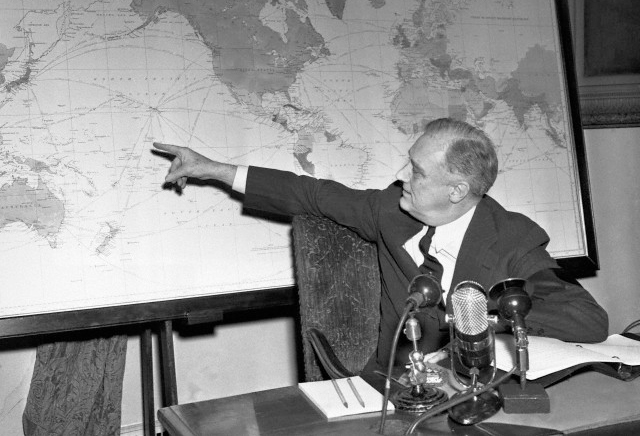 |
| FDR at his fireside chat "On the Progress of the War" for Feb. 23, 1942. Photo from Library of Congress and Wikimedia Commons |
For some time President Franklin D. Roosevelt (FDR) had addressed the American people during times of crisis and concern by using a device called "the fireside chat." A brilliant leader and politician, FDR went directly to the people, speaking to them over the radio. Ordinary people sitting by their radios, often by their firesides, would huddle together and listen to this great leader. He would speak calmly and reassuringly. He would tell them the truth -- good or bad -- but he would reassure them that he and the government were dealing with whatever serious matter was at hand.
On February 23, 1942, just a few weeks after the horrendous attack on the American base at Pearl Harbor and while the Japanese were defeating American and Filipino troops in the Philippine Islands, FDR addressed the nation on the course of the war. (Listen to FDR's chat here at UVA Miller Center.)
 |
| The USS Arizona, destroyed by the Japanese attack at Pearl Harbor on Sunday, December 7th, 1941 Photo from the National Archives and Wikimedia Commons |
People had been told in advance to get a map of the world from whatever source they could as the president would be talking about American troop movements worldwide and grand strategy. Although America was initially attacked by Japan, and later Germany declared war on the USA, Roosevelt had to convince the American public of the correctness of moving most of our resources first against Nazi Germany and then moving against Japan.
 |
| American and Filipino troops surrender to the Japanese at Bataan in 1942 Photo from Wikimedia Commons and US military |
President Roosevelt had told his aides, "I'm going to speak about strange places that many of them never heard of -- places that are now the battleground for civilization."
FDR was sure that if he told the truth to the American people, they would understand and follow his lead. He had already led them through the worst economic crisis in American history, The Great Depression. Now he had to lead them through a world war where the very life of the nation, if not the whole planet, was at stake.
Roosevelt started out by explaining how Americans during the Revolutionary War suffered many early defeats and hardships, yet America prevailed in the end. He used that comparison to reassure the people that although the war was going badly in early 1942, things would get better.
 |
| FDR's enemies: Japanese making a Banzi victory salute after defeating the Americans on Bataan in the Philippines, 1942 Photo from Wikimedia Commons and NARA (National Archives and Records) |
He then referred to the world map, as people at home followed along on their own maps, and explained how the USA would prevail in this war too.
FDR explained how the vastness of the scope of the war would make this different from most other wars. War would rage in Europe, Asia, the Pacific, Africa, and circling the globe to even distant Australia and the seas near South America and all the way to Alaska. He explained clearly to the American people that the war would be long and hard, but he rejected pessimism and defeatism.
This was the same man who struggled against the disease of polio which left him in a wheelchair. This was the same man who once said to a broken, dispirited American nation at the lowest point of the Great Depression that "the only thing we have to fear is ... fear itself." Now this same man, Franklin Roosevelt, used that same incredible sense of confidence in the face of extreme adversity to build up the American people for the brutalities of world war.
 |
| FDR's enemies: Adolf Hitler and German Field Marshal Walter von Brauchitsch examining a map of the Soviet Union during the Nazi invasion of Russia |
His February 23rd fireside chat was called "On the Progress of the War." He explained in clear terms why the USA had to fight on distant lands and on distant seas.
Then President Roosevelt challenged the Axis powers and their warped and false beliefs about America directly. FDR said, "From Berlin, Rome, and Tokyo were have been described as a nation of weaklings -- 'playboys' -- who would hire British soldiers, or Russian soldiers, or Chinese soldiers to do our fighting for us ... Let them tell that to General MacArthur and his men. Let them tell that to the sailors who today are hitting hard in the far waters of the Pacific. Let them tell that to the boys in the Flying Fortresses ..." And then President Roosevelt finished by saying, "Let them tell that ... to the Marines!"
FDR made it clear in this fireside chat that America would fight and keep on fighting.
In the end his speech was a success, the American people were convinced and reassured, and the war went on with a clear plan and a clear goal.
From the depths of seemingly endless Allied and American defeats, President Franklin D. Roosevelt now sought the complete defeat of America's enemies.
Sources and Further Reading:
Photo of FDR and the world map at Wikipedia; A recording of FDR's speech for Feb. 23, 1942, "On the Progress of the War" UVA, Miller Center; photo of US troops surrender at Bataan Wikimedia Commons; photo of USS Arizona Wikimedia and NARA National Archives; Japanese making Banzi salute in Bataan Wikimedia Commons ; photo of Hitler and German field marshal Wikimedia Commons

No comments:
Post a Comment